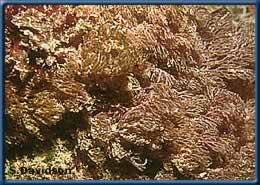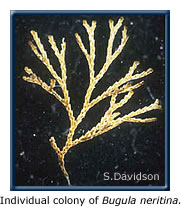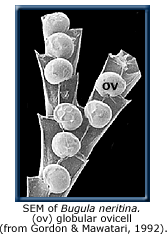

Schizoporella errata

Amathia distans

Bugula neritina
Bugula neritina
 Brown
bryozoan
Brown
bryozoan
Phylum Ectoprocta
Class Gymnolaemata
Order Cheilostomata
Family Bugulidae
Description
Flexible bushy colonies, branching biserial, to about 10 cm high. Color
is purplish-brown. Zooids alternating, with the outer corner pointed,
but not spined. No avicularia, ovicell large, white, and globular (from
Gordon & Mawatari, 1992).
Habitat
Typically found in harbors and embayments, especially Pearl Harbor, intertidal
to 5 m, attached to any available hard substrate.
 Distribution
Distribution
Hawaiian Islands
Throughout the main islands, in harbors, embayments, and shallow reef
areas.
Native Range
Unknown, perhaps the Mediterranean
Present Distribution
Worldwide in tropical and temperate seas
Mechanism of Introduction
Unintentional, most likely as fouling on ships' hulls.
Impact
Fouling organism. Ecological impact unstudied, likely some competition
for space with native species.
Ecology
Feeding
The bryozoan is a suspension feeder. It has a retractable U-shaped crown
of tentacles (lophophore) which bear cilia that create a current, bringing
food particles toward the animal. Particles are then guided into the mouth
by action of the tentacles and cilia.
 Reproduction
Reproduction
Each bryozoan colony begins from a single, sexually produced, primary
zooid. This zooid undergoes asexual budding to produce a group of daughter
cells, which themselves form buds, and so on. Most bryozoans are hermaphroditic,
each zooid capable of producing sperm and eggs. Sperm is released into
the coelom and the fertilized eggs are retained and brooded for a time
before being released.
Remarks
A common fouling organism worldwide, reported from all seas except subarctic
and subantarctic regions, this species is most likely a suite of very
similar species. It's presence in Hawaii was first reported by Edmondson
(1933). He noted that it was one of the most common fouling species in
harbors and bays around Oahu. It has since been widely reported throughout
the main Islands by a number of authors.
Recently, B. neritina has been a subject of a great deal of biochemical
research. It is the source of a novel chemical, bryostatin, which has
been shown been effective against leukemia.
There are three additional alien species of Bugula reported in Hawaii;
B. dentata, B. robusta, and B. stolonifera (Zabin, 1999).
References
Edmondson, C.H. 1933. Reef and Shore Fauna of Hawaii. B.P. Bishop Museum
Spec. Pub. 22.
Gordon, D.P. and S.F. Mawatari. 1992. Atlas of marine-fouling Bryozoa
of New Zealand ports and harbours. New Zealand Oceanographic Institute,
Pub. 107: 1- 52.
Zabin, C.J. 1999. New records of introduced fouling Bryozoa from Oahu,
Hawaii. Occ. Pap. Bishop Mus. 59: 46-47.
© 2002 Hawaii Biological Survey, Bishop Museum
contact